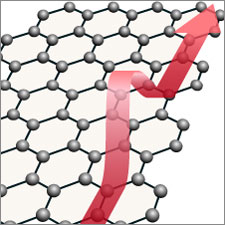Control of plasmon transport in graphene
Towards the realization of low-power-consumption nanoscale circuits using electron waves

NTT Basic Research Laboratories(NTT-BRL) and Tokyo Institute of Technology have succeeded in controlling the velocity of plasmons*1, which are collective charge oscillations, over two orders of magnitude using graphene*2. In graphene, different from conventional bulk metal, properties of plasmons can be tuned by changing the carrier density, magnetic field and gate screening effect.
The tunability of the plasmon velocity suggests that it is possible to control optical signals through plasmons in nanoscale regions. In the future, by replacing electronic circuits with plasmonic ones, it would be possible to reduce the power consumption of computers and network facilities.
This result has been published in the January 15 issue of Nature Communications.
Plasmon transport in graphene investigated by time-resolved electrical measurements
Nature Communications 15 January 2013
=> Quantum Solid State Physics Research Group

Fig.1:Time-resolved transport measurement
We generate plasmons in graphene by applying a voltage step to an additional small gate electrode (the injection gate) deposited on the edge of graphene. The plasmons propagate in graphene and are detected in the time domain through an electrical contact 1.1 mm away from the injector. Velocity is obtained from the time of flight of plasmons and the path length.

Fig.2: Plasmon velocity in graphene
The plasmon velocity varies over two orders of magnitude between 104 and 106 m/s by changing the magnetic field, the carrier density and the gate screening effect.
*1 ... plasmon
Plasmon is a collective charge oscillation. Plasmons can be confined in the size dimensions of electronic devices (- 10 nm). Data transfer by plasmons is expected to have a much smaller loss than that by electric current.
*2 ... graphene
Graphene is a monolayer of carbon atoms arranged in a hexagonal lattice. Graphene has been attracting much interest both in basic research and applications owing to its unique physical properties and high mobility.










